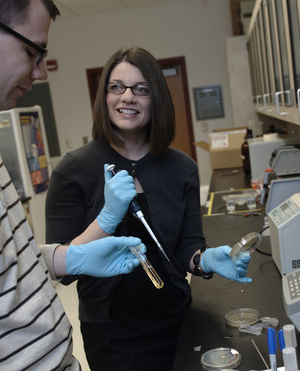October 28, 2014
Tami Sivy - Assistant Professor of Chemistry
Biochemist researches quality of water and life in watershed
Tami Sivy joined SVSU in 2008, as an assistant professor of chemistry. Originally from Allendale, Mich., she was pleased to return
to her home state after earning a Ph.D. from the University of Colorado-Boulder. She and her family live on the Kawkawlin River,
which is especially meaningful to her since much of her research is centered on the river’s health.
Sivy concluded the interview with her thoughts about her talented chemistry department cohorts and the real value to our students
of SVSU being a “teaching” university. To hear her thoughts, visit http://www.svsu.edu/reflections/spring2013 for a brief video.
How did you come to pursue a career in biochemistry?
Ever since I was young, interested in science and knew I would end up studying it somehow. I liked chemistry and biology, so ultimately biochemistry made sense. I’m fascinated with how things work. Chemistry is so logical; you can figure things out with fundamental principles. Taking chemistry and applying it to a cell —it’s an amazing way to explain what happens in life.
As a biochemist, you look at the interactions of bio-molecules. Tell us non scientists why this is important?
(Laughs). It really is about cell survival. When the interactions within and between molecules are functioning correctly, the suggestion is that things are healthy. When the interactions go awry, there’s the possibility of disease. While this may appear to apply to questions only asked through a medical lens, biochemistry is used in many more applications, as seen in my own research.
What is your research focus?
We study a biochemical pathway in plants and bacteria from which is produced a volatile compound called “isoprene.” As a researcher, I am interested in understanding why it is being made in the cell. Through a medical lens, the ramifications are important because compounds synthesized from isoprene units can be important pharmaceuticals. Through an atmospheric chemistry lens, it’s important to understand how and why many plants and bacteria produce isoprene and what its impact is on climate change.
 SVSU is primarily a teaching university. You’re a researcher, but can you comment on your role as a teacher?
SVSU is primarily a teaching university. You’re a researcher, but can you comment on your role as a teacher?
While I enjoy research, teaching is definitely what I feel I was called to do. I teach primarily 400-level courses, so most of my students are in pre-health programs and in majors where they are going on to grad school. I hear from students that my courses were challenging but that ultimately, the students were well prepared. Other than my role as a mom, nothing gives me greater satisfaction than seeing students make connections in biochemistry so that they can say they “get it.”
We understand that this work is part of the new Saginaw Bay Environmental Science Institute of SVSU. Can you tell us about the institute?
I am privileged to be a part of this institute that is really due to the efforts of Dave Karpovich, dean Deborah Huntley, the university’s administration and a host of regional and state organizations that have been committed for a long time to the Saginaw Bay area. The research in the Saginaw Bay watershed is really about the quality of water and quality of life in our own region. There has always been a fair amount of research going on here but there’s not been a clearinghouse or mechanism to gather data, discuss the work and disseminate the results. The institute will pull together various ‘players’ from the university and the region, including Delta College, Michigan Department of Environmental Quality (DEQ), the Spicer Group, Bay County Health Department, Kawkawlin River Property Owners Association and the Saginaw Bay Watershed Initiative Network. SVSU’s footprint on this region’s environmental sciences will be more obvious and more prominent than before.
What will be your contribution?
My work, which started as a collaborative effort with the Bay County Health Department, will focus on rapid bacterial testing of water. The cutting edge instrumentation for the rapid testing—results in four hours instead of the standard 24 hours—is housed at the university, and our students are involved in the collection and testing of the samples.
Tell us about your recent Michigan [DEQ] grant?
David Karpovich (H. H. Dow Endowed Chair in Chemistry), Jacob Van Houten (Delta College) and I received a $35,365 grant to learn more about why the Kawkawlin River is so unhealthy, which is indicated by its low content of dissolved oxygen.
How do our students benefit from this marriage of teaching and research?
As a smaller school, SVSU provides a special opportunity for students to be involved in research and to have access to professors who can help prepare them for whatever is next for that student. The students appreciate the relationships they have with their professors. These relationships are evident from things like letters of recommendation—our students know us and we know them, and that interaction is invaluable.
